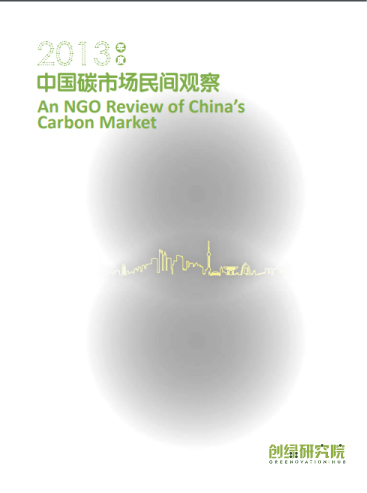
Download Report: www.ghub.org/chinaets2013.pdf
Greenovation Hub - A Chinese Environmental NGO, recently published An NGO Review of China’s Carbon Market 2013, which has been the first ever assessment of China’s carbon emissions trading (ETS, Emissions Trading System) pilots from the perspective of civil society. The report points out, “The year of 2013 is the first year of carbon trading by the pilots. Shenzhen, Shanghai, Beijing, Guangdong Province and Tianjin launched their carbon trading pilots before the end of the year, which has a significant demonstration effect for China’s future carbon market. However, as it is laying down the foundation and exploring opportunities, China’s carbon market is facing potential challenges and risks. The quality and sufficiency of emission statistics is far from satisfactory; the cap setting is at risk of being too loose and this flexibility could potentially have a negative impact on the market; the consideration of reserves for emission growth space as well as the interactions with other policies relevant to national energy development and pollutant control still needs improvement.”
With the increasing significance of the energy security and environmental issues, together with the growing pressure of global climate action, China is taking more efforts to improve energy conservation and emissions reduction. China launched the regional carbon trading pilots in 2013, as one of the market-based policy tools available to achieve energy conservation and emissions reduction at a lower cost. Given the current the total emission allowance allocation of the pilots (65-70 million tonnes), China is going to be the second largest carbon market right behind the EU ETS in the world. Therefore, the scheme development of the carbon market is of critical importance to China’s carbon pricing policies and the global greenhouse gas emissions reduction efforts.
The report assesses the operation of China’s carbon trading pilots from four aspects, namely scheme design, scheme implementation, market performance, transparency and stakeholder engagement. Based on the analysis of the publicly available information related to the seven pilots up to November 5th, 2013, the report recommends, “Ensure sufficient and steady direction for the market in terms of the scheme design and the cap setting, particularly, should provide reliable direction for the absolute cap setting. The cap’s flexible adjustment needs to ensure not to generate any reverse incentives that make negative impacts to the market. Meanwhile, cap setting should take into consideration of carbon market and energy efficiency policies, as well as the energy conservation goals imposed on key companies. As for scheme implementation, power sector is faced with structural challenges. The particular choice of double “regulating” the upstream and downstream (both the direct emissions from the power sector and indirect emissions of electricity and heating of industries are covered in each pilot region) and its implications still need careful assessment and examination. The legal basis and punishment/compliance system seem to be inadequate in terms of the existing practices. Monitoring Report and Verification (MRV) mechanisms, management of third-party qualification and market risk control also need further improvement. In addition, specific provisions are lacking for the use and management of revenues (both existing and potential) generated by the carbon market. In the past six months, Shenzhen carbon trading pilot saw a total volume of nearly 200,000 tonnes, with the value of 13 million Yuan, whose market activity and fluidity is relatively better compared to other second-level carbon markets in China.
As an important supplement to the Cap and Trade System, the Chinese Certified Emission Reduction (CCER) market was established in parallel, which offers opportunity for further development as well as challenges to China’s carbon offset projects. In addition to the examination of the balance between the supply and demand of offset projects, the consideration of emission allowances allocation and carbon trading prices, the report raises concerns about the “gray” offset programs which have substantial emission reduction to the trading system yet with very low environmental and social effectiveness. Appropriate management programs need to be formulated to ensure that the carbon offset mechanism can effectively and efficiently promote carbon emission reduction with a low cost while taking into consideration multiple factors such as social and environmental safeguards, sustainable development and technology transfer.
As carbon trading pilots are still in infancy and face various challenges in China in 2013, transparency and stakeholder engagement are critical to the future development of China’s carbon market. By far, China’s carbon market falls short with regards to information disclosure and data accuracy. It also largely lacks public and stakeholder engagement mechanism or channels. Based on the international experiences, carbon market’s development should be a continuous process of identifying and correcting shortcomings and mistakes, as well as a process of continuous participation of stakeholders, to collectively explore ideas, review experiences and improve policy design and implementation.
The report points out, “The utmost goal of forming an effective carbon market is to reduce greenhouse gas emissions, which is also key for global efforts of combating climate change. As such, the process of carbon market development requires a comprehensive thinking and practices, the participation and discussion of different stakeholders, as well as an effective market monitoring and public supervision, in order to ensure the functioning of the market and fulfilment of its objectives in a fair and effective manner. We plan to continue the annual review of China’s carbon market via a more data-based, multi-stakeholder approach and objective analysis in the coming years. We will promote the formation of an encompassing and open carbon market policy discussion that involves multiple actors/stakeholders and draws on the best domestic and foreign experiences and lessons, so as to ensure a smooth policy formulation and implementation and avoid mistakes.”



